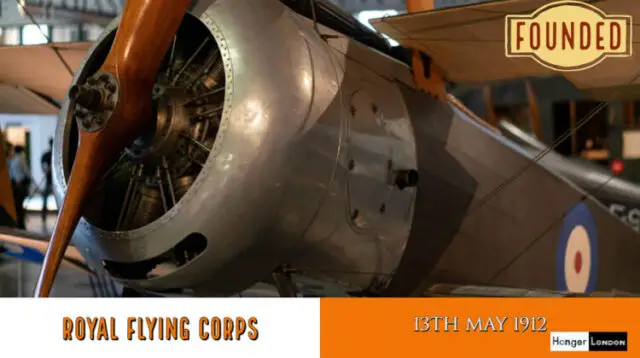The Birth of the Royal Flying Corps in London: A Historical Overview
The Royal Flying Corps (RFC) was formed in 1912 as part of the British Army, and its roots can be traced back to London. The city played a vital role in the development of British aviation, with pioneering aviators such as Samuel Cody, A.V. Roe, and Claude Grahame-White conducting early experiments in flight around the capital.
The first RFC squadrons were based in Farnborough, Hampshire, but London quickly became an important hub for the Corps. The RFC’s headquarters were located at 15 Strand, near Trafalgar Square, and it established training schools at Hendon and Brooklands, both within easy reach of the city.
As the RFC grew, so did its connections with London. The Corps played a major role in the city’s cultural and social life, with aviation displays and demonstrations drawing large crowds. The RFC’s pilots became celebrities, with their exploits reported in the press and their bravery celebrated in public events.
Today, London’s aviation heritage can be traced back to the early days of the RFC, and the city remains a hub of innovation in the aerospace industry.
London’s Vital Role in Supporting the Royal Flying Corps During WWI
When World War I broke out in 1914, the Royal Flying Corps was still a fledgling organization. However, London quickly became a vital part of the Corps’ war effort. The city was a key hub for the transportation of personnel and equipment, and it played a crucial role in the development and manufacture of new aircraft.
In the early days of the war, the RFC was primarily used for reconnaissance, but it soon became clear that aerial combat would be a crucial part of the conflict. London’s proximity to the front lines meant that it was an ideal location for training pilots and developing new tactics and technologies for air warfare.
The RFC’s training schools at Hendon and Brooklands became important centers of innovation, with engineers and designers working on new aircraft and weapons. London also became a hub for the manufacture of aircraft engines, with companies such as Rolls-Royce and Sunbeam producing engines for the RFC’s planes.
By the end of the war, the RFC had become the world’s largest air force, and London had played a vital role in that success.
RFC Bases in London: Exploring the Capital’s Aviation Heritage
London is home to many sites that played a significant role in the history of the Royal Flying Corps. Hendon Aerodrome, located in north London, was the site of one of the RFC’s most important training schools. Today, the aerodrome is home to the Royal Air Force Museum, which houses a collection of aircraft and artifacts that tell the story of the RAF and its predecessor organizations, including the RFC.
Brooklands, located in Surrey just outside London, was another important RFC training base. The site is now home to the Brooklands Museum, which celebrates the history of British motorsport and aviation. The museum’s collection includes a number of aircraft that were used by the RFC, as well as exhibits on the Corps’ role in World War I.
London is also home to a number of memorials and monuments dedicated to the RFC and its personnel. The Royal Air Force Memorial on the Embankment in central London commemorates the sacrifices made by all members of the RAF and its predecessor organizations, including the RFC. Meanwhile, the Hendon Aerodrome Memorial commemorates the lives of the RFC’s pilots and ground crew who lost their lives during World War I.
Exploring London’s aviation heritage is a fascinating way to learn about the city’s history and the role it played in the development of aviation and air warfare.
The Impact of RFC Training Schools on London’s Aviation Industry
The Royal Flying Corps training schools in London had a significant impact on the city’s aviation industry. Hendon Aerodrome and Brooklands became hubs of innovation, with engineers and designers working on new aircraft and technologies.
The RFC’s training schools were also instrumental in developing new pilots for the aviation industry. Many of the pilots trained at Hendon and Brooklands went on to become commercial pilots or played important roles in the development of the aviation industry.
London’s aviation industry continued to thrive after the war, with companies such as de Havilland and Handley Page producing some of the most innovative and important aircraft of the interwar period. The RFC’s legacy can be seen in the continuing innovation and excellence of the city’s aviation industry.
RFC Heroes: Remembering Londoners Who Served in the Corps
The Royal Flying Corps was made up of pilots and ground crew from all over the UK and the Commonwealth, but London played a significant role in the Corps’ war effort. Many Londoners served in the RFC, and their bravery and sacrifice should be remembered.
One of the most famous Londoners to serve in the RFC was Major William Leefe Robinson. Robinson shot down a German airship over London in 1916, becoming the first person to achieve this feat. He was awarded the Victoria Cross for his bravery.
Other notable Londoners who served in the RFC include Captain Albert Ball, who was one of the Corps’ most successful pilots and shot down 44 enemy aircraft before being killed in action, and Lieutenant Cecil Lewis, who wrote one of the most famous memoirs of the war, “Sagittarius Rising.”
Remembering the sacrifices and achievements of Londoners who served in the RFC is an important part of the city’s history.
The Legacy of the RFC in London: How Aviation Innovation Continues to Thrive Today
The Royal Flying Corps had a significant impact on London and the aviation industry, and its legacy can still be seen today. London remains a hub of innovation in the aerospace industry, with companies such as Rolls-Royce and BAE Systems producing some of the most advanced aircraft and aerospace technologies in the world.
London is also home to a number of major airports, including Heathrow and Gatwick, which are among the busiest airports in the world. The city’s aviation industry employs thousands of people and generates billions of pounds for the UK economy.
The Royal Air Force Museum, located at Hendon Aerodrome, is an important reminder of the RFC’s legacy and the importance of aviation to the UK’s history and economy. The museum’s collection includes a number of aircraft and artifacts from the RFC and its successor organizations, as well as exhibits on the history of British aviation.
The legacy of the RFC in London is a testament to the importance of innovation, bravery, and sacrifice in the development of aviation and air warfare.
The RFC and London’s Role in the Birth of the RAF
In 1918, the Royal Flying Corps merged with the Royal Naval Air Service to form the Royal Air Force, which would become one of the most important institutions in the UK’s history. London played a key role in the birth of the RAF, with the new organization being headquartered in the city.
The RAF’s formation was a crucial step in the development of air power and air warfare, and it marked the beginning of a new era in the history of the UK’s military. The RAF played a key role in the country’s defense during World War II, and it continues to be an important part of the UK’s armed forces today.
The RFC’s legacy can be seen in the continuing importance of air power and the RAF in the UK’s defense and security. London’s role in the birth of the RAF is a testament to the city’s importance as a center of innovation and excellence in aviation.
Commemorating the RFC’s Legacy in London
Commemorating the legacy of the Royal Flying Corps in London is an important part of the city’s history. There are a number of ways to remember and honor the contributions of the RFC to the development of aviation and the UK’s military.
One of the most important ways to commemorate the RFC’s legacy is to visit the Royal Air Force Museum at Hendon Aerodrome. The museum’s collection includes a number of aircraft and artifacts from the RFC and its successor organizations, as well as exhibits on the history of British aviation.
Another way to honor the RFC’s legacy is to visit the graves and memorials of RFC personnel who died during the war. The Brookwood Military Cemetery, located just outside of London, is the final resting place of many RFC personnel, including pilots and ground crew.
Finally, remembering the contributions of the RFC to the development of aviation and the UK’s military is an important part of the city’s history. The bravery and sacrifice of the men and women who served in the RFC should be remembered and celebrated as part of London’s proud tradition of innovation and excellence in aviation.
RFC Facts
- The Royal Flying Corps was part of the British Army, Split into two, an Army Wing and a Naval Wing which was to be under the command of the Royal Navy. All that eventually changed when the two wings merged to create The Royal Airforce (RAF). The RAF also eventually split into Fighter Command, Bomber Command, etc. but that is for a different post.
- WW1 proved to be a technical race for faster and more reliable aircraft, The Germans had the Albatross, and Fokker planes which proved far superior to anything the British had. The Tide turned once more when the Brits developed the Sopwith Camel, Bristol Fighter
- 900,000 hours were logged by the Royal Flying Corps in WW1
- When the Royal Flying Corps deployed to France in 1914, 4 squadrons of 12 aircraft were sent, 36 aircraft with 15 further planes, by 1918 the total aircraft inventory was 22,000 planes.




